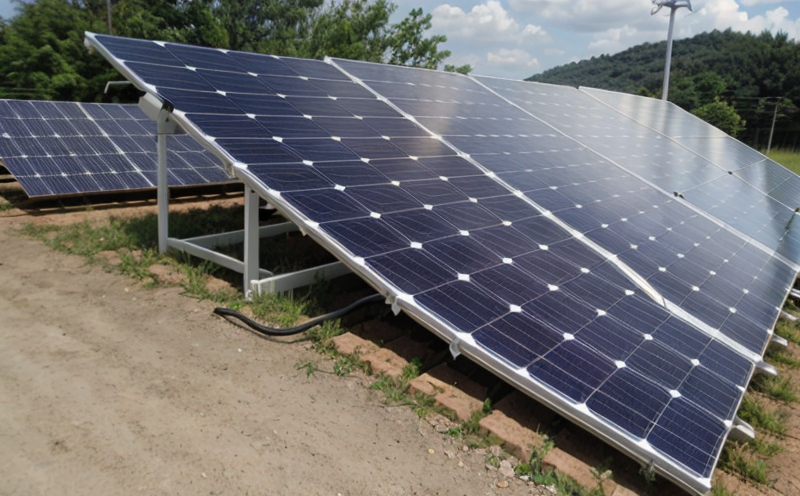IEC 60904-10 Methods of Linearity Testing for PV Devices
The International Electrotechnical Commission (IEC) 60904-10 standard provides methodologies to test the linearity characteristics of photovoltaic (PV) devices. This testing is crucial as it ensures that PV modules and panels operate within specified limits, maintaining efficiency and reliability over their operational life. Linearity testing evaluates how closely a device's output voltage follows its input current under different conditions.
The primary focus of this test involves the use of load resistors to simulate various operating conditions. The standard outlines several methods for performing these tests, including direct measurement using precision instruments like digital multimeters and data loggers. Compliance with IEC 60904-10 is essential for manufacturers aiming to ensure their products meet international standards.
For quality managers and compliance officers, linearity testing helps in identifying potential issues early on during the manufacturing process. R&D engineers benefit from this test as it aids in optimizing design parameters leading to improved performance and longevity of PV devices. For procurement professionals, ensuring suppliers adhere to such stringent tests is critical for maintaining high-quality standards across the supply chain.
The methodology involves applying a known current through the device under test (DUT) while measuring both voltage and power output simultaneously. The results are then compared against expected values derived from theoretical models or previous test data. Any deviation can indicate non-linear behavior that needs addressing before commercialization.
It is important to note that accurate measurement techniques play a significant role in obtaining reliable linearity test results. Precision instruments such as digital multimeters and data loggers are recommended for this purpose. Additionally, environmental factors like temperature must be controlled during testing to avoid influencing the outcome of the measurements.
The IEC 60904-10 standard also specifies acceptance criteria which define acceptable limits within which a PV device should operate linearly. These criteria vary based on the type and size of the PV module being tested but generally aim at ensuring that any deviation from expected behavior falls below specified thresholds.
Understanding these requirements is vital for manufacturers who want their products to comply with international standards while also meeting customer expectations regarding performance reliability.
- Environmental Impact: Ensures efficient use of resources by reducing energy waste through accurate PV operation.
- Sustainability: Promotes sustainable practices by encouraging the production and use of high-quality, reliable solar power systems.
- Economic Benefits: Reduces costs associated with maintenance and replacement due to improved product longevity.
In conclusion, adhering to IEC 60904-10 ensures that PV devices perform reliably under various conditions, contributing positively towards achieving sustainable energy goals. This standard not only enhances the quality of solar products but also promotes trust among consumers by providing assurance about their functionality and durability.
Benefits
Performing IEC 60904-10 linearity tests offers numerous benefits that extend beyond mere compliance with international standards. One key advantage is the enhancement of product reliability, ensuring consistent performance over extended periods without degradation in efficiency.
For manufacturers, these tests provide valuable insights into potential areas for improvement, allowing them to refine their designs and processes continuously. This continuous optimization leads to better quality products that can compete effectively in global markets.
From a consumer perspective, reliable PV devices mean lower operational costs over time as there is reduced need for frequent replacements or repairs. Additionally, the consistent output provided by these devices contributes significantly towards achieving long-term energy savings goals set forth by various governments worldwide.
The environmental aspect cannot be overlooked either; by ensuring efficient use of resources and minimization of waste associated with poorly performing PV systems, IEC 60904-10 promotes sustainable practices throughout the lifecycle of these devices. This aligns closely with broader sustainability initiatives aimed at reducing carbon footprints across industries.
In summary, incorporating linearity testing into your quality assurance processes yields tangible advantages ranging from improved product performance to enhanced customer satisfaction and reduced environmental impact. Investing in such tests demonstrates a commitment to excellence that resonates well both internally within organizations as well as externally with stakeholders including customers and regulatory bodies alike.
Why Choose This Test
Selecting IEC 60904-10 linearity testing for your PV devices is a strategic decision driven by several compelling reasons. Firstly, it underscores your commitment to delivering high-quality products that meet or exceed international standards. Compliance with this standard not only enhances the reputation of your brand but also opens doors to broader market acceptance and potentially greater sales opportunities.
Secondly, choosing this test allows you to identify and rectify any non-linearities early in the production process. Early detection helps minimize costs associated with rework or scrap, thereby improving overall profitability. It also ensures that only high-performance products reach end users, enhancing customer satisfaction levels.
A third reason for opting for IEC 60904-10 lies in its role as a key differentiator among competitors. By demonstrating superior quality through rigorous adherence to international standards, you position yourself favorably against other manufacturers who may not prioritize similar testing procedures. This competitive edge can translate into stronger market positions and loyal customer bases.
Lastly, selecting this test aligns your company with broader industry trends towards increased emphasis on sustainability and energy efficiency. As global awareness grows about the importance of renewable energy sources like solar power, adhering to stringent quality assurance measures such as IEC 60904-10 becomes increasingly relevant. It signals a proactive stance towards contributing positively towards environmental goals while simultaneously delivering value to stakeholders.
In summary, choosing IEC 60904-10 linearity testing for your PV devices offers multiple benefits including enhanced product reliability, reduced operational costs, improved customer satisfaction, stronger competitive positioning, and alignment with sustainability initiatives. By making this choice, you contribute not just to the success of your own organization but also to the broader goals of advancing renewable energy technologies.





